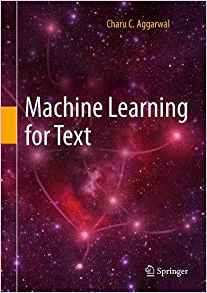Machine Learning for Text
This book covers machine learning techniques from text using both bag-of-words and sequence-centric methods. The scope of coverage is vast, and it includes traditional information retrieval methods and also recent methods from neural networks and deep learning.
Sponsored Post.

Machine Learning for Text, Springer, March 2018
Charu C. Aggarwal.
Comprehensive textbook on machine learning for text: Table of Contents
PDF Download Link (Free for computers connected to subscribing institutions only)
Buy hard-cover or PDF (for general public)
Buy low-cost paperback edition using link on right of destination page (A link for buying the softcover at the discounted price of $25 shows on the destination page for computers connected to subscribing institutions only)
This book covers machine learning techniques from text using both bag-of-words and sequence-centric methods. The scope of coverage is vast, and it includes traditional information retrieval methods and also recent methods from neural networks and deep learning. The chapters of this book can be organized into three categories:
Classical machine learning methods: These chapters discuss the classical machine learning methods such as matrix factorization, topic modeling, dimensionality reduction, clustering, classification, linear models, and evaluation. All these techniques treat text as a bag of words. Contextual learning methods that combine different types of text and also combine text with heterogeneous data types are covered.
Classical information retrieval and search engines: Although this book is focussed on text mining, the importance of retrieval and ranking methods in mining applications is quite significant. Therefore, the book covers the key aspects of information retrieval, such as data structures, Web ranking, crawling, and search engine design. Importance is given to different types of information retrieval scoring models and learning-to-rank techniques.
Sequence-centric, deep learning, and linguistic methods for mining: While the bag-of-words representation can be useful for traditional applications like classification and clustering, more advanced applications like machine translation, image captioning, opinion mining, information extraction, and text segmentation require one to treat text as a sequence. These chapters discuss methods for sequence-centric mining methods such as deep learning techniques, word2vec, recurrent neural networks, LSTMs, maximum entropy Markov models, and Conditional Random Fields. Custom methods for applications like text summarization, opinion mining, and event detection are also discussed.
The book can be used as a textbook and it contains numerous exercises. However, it is also designed to be useful to researchers and industrial practitioners. It therefore contains extensive bibliographic references for researchers, and the bibliographic section also contains software references for practitioners. Numerous examples and exercises have been provided.
Obtaining electronic and hardcopy versions
The book is available in both hardcopy (hardcover) and electronic versions. The hardcover is available at all the usual channels (e.g, Amazon, Barnes and Noble etc.), in Kindle format, and also directly from Springer in hardcopy and pdf format. The electronic version is available at the following Springerlink pointer . For subscribing institutions click from a computer directly connected to your institution network to download the book for free. Springer uses the domain name of your computer to regulate access. To be eligible, your institution must subscribe to "e-book package english (Computer Science)" or "e-book package english (full collection)". Aside from the fact that the PDF version is freely downloadable from subscribing institutions, it is preferable to the paid Kindle version in terms of formatting. The electronic PDF does have embedded links and you can also load it on a Kindle reader.
